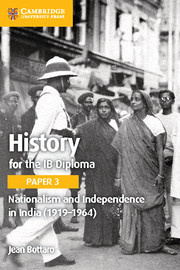Description
Nationalism and Independence in India (1919-1964) (2nd Ed.)
IB Diploma Series
Author: Bottaro Jean
Language: EnglishApproximative price 26.32 €
In Print (Delivery period: 14 days).
Add to cart
Publication date: 08-2016
326 p. · 15.3x23.1 cm · Paperback
326 p. · 15.3x23.1 cm · Paperback
Description
/li>Contents
/li>
Comprehensive books to support study of History for the IB Diploma Paper 3, revised for first assessment in 2017. This coursebook covers Paper 3, HL option 3: History of Asia and Oceania, Topic 10: Nationalism and Independence in India (1919-1964) of the History for the International Baccalaureate (IB) Diploma syllabus for first assessment in 2017. Tailored to the requirements of the IB syllabus, and written by an experienced examiner and teacher it offers an authoritative and engaging guidance through nationalism in India, from the end of World War I to the achievement of Indian independence and the development of the country.
1. Introduction; Chapter 2. The origins of Indian nationalism and the impact of the First World War: 2.1. What were the origins of the nationalist movement in India?; 2.2. How did the First World War affect India?; 2.3. To what extent did the demands for Home Rule boost the nationalist movement?; Chapter 3. Political developments between 1919 and 1935: 3.1. To what extent was the Amritsar Massacre a turning point?; 3.2. How did the Government of India Act (1919) affect India?; 3.3. What was the significance of the Simon Commission?; 3.4. How effective were the Round Table Conferences?; 3.5. What were the responses to the Government of India Act, 1935?; Chapter 4. The role and importance of key groups and individuals: 4.1. What role did the Indian National Congress play in the nationalist movement?; 4.2. How important was the All-India Muslim League in the nationalist movement?; 4.3. Why was Gandhi so important to the nationalist movement?; 4.4. What was Nehru's contribution to the nationalist movement?; 4.5. How significant was Jinnah's role in the nationalist movement?; Chapter 5. The struggle for independence: 5.1. What was the Non-Cooperation movement?; 5.2. Why was the Salt March so significant?; 5.3. What happened during further Civil Disobedience campaigns?; 5.4. Why was the 'Quit India' campaign significant?; Chapter 6. The growth of Muslim separatism: 6.1. What was the background to the growth of Muslim separatism?; 6.2. When and how did the 'Two Nation' theory develop?; 6.3. How significant was the Lahore Resolution?; Chapter 7. The impact of the Second World War: 7.1. How did the Second World War affect India?; 7.2. What role did Subhas Chandra Bose play?; 7.3. Why did the Cripps Mission fail?; 7.4. How did the war affect British power in India?; 7.5. What was the situation in India after the war?; Chapter 8. Independence and partition: 8.1. What role did Mountbatten play?; 8.2. How did India achieve independence?; 8.3. What were the reasons for the partition of the South Asian subcontinent?; Chapter 9. Post-independence India: 9.1. What ethnic and religious conflicts did India face?; 9.2. How were the princely states incorporated?; 9.3. Why was there conflict with Pakistan over Kashmir?; 9.4. To what extent were Nehru's domestic policies successful?; Chapter 10. Exam practice; Further Reading; Index.
© 2024 LAVOISIER S.A.S.





